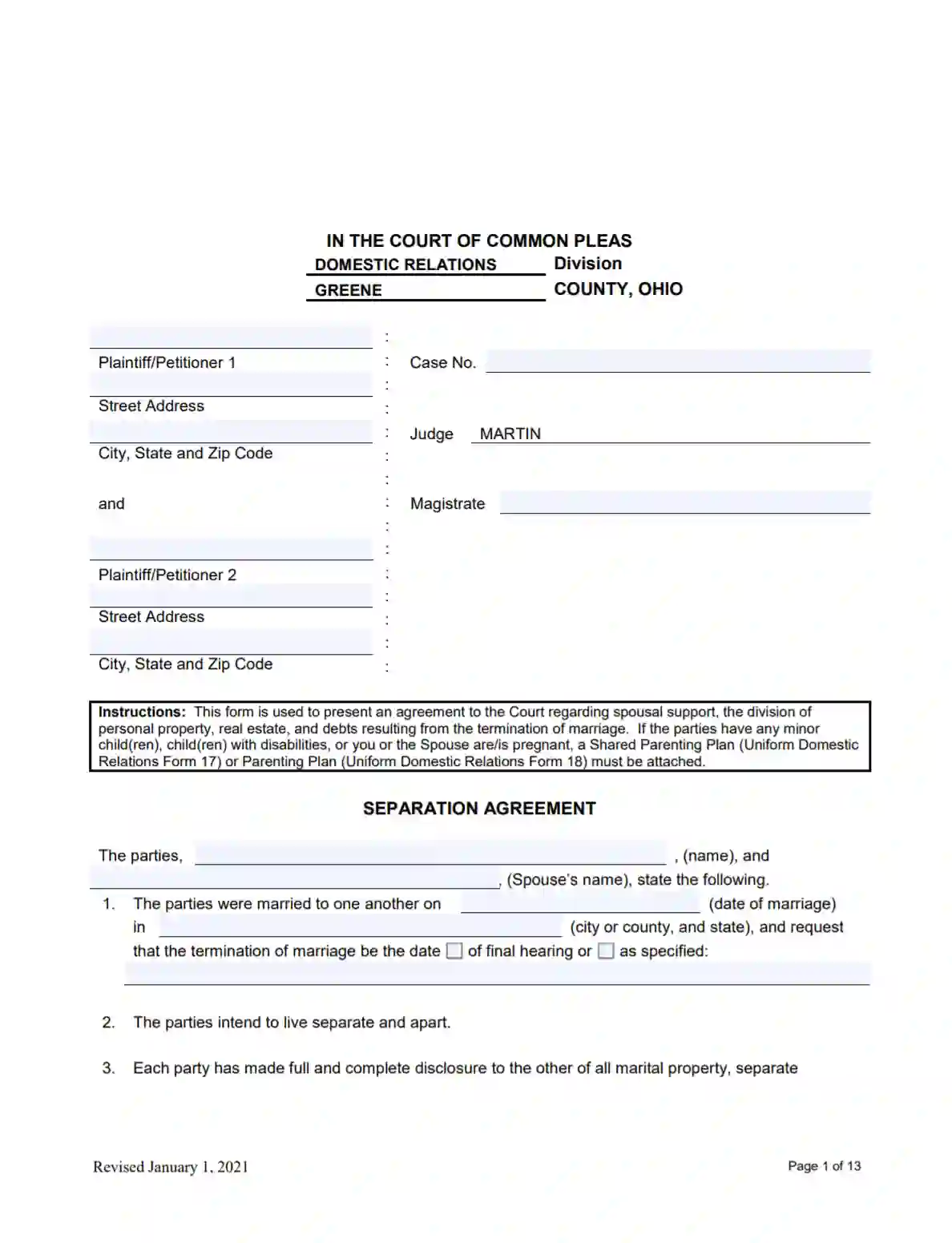Ohio Marital Settlement (Divorce) Agreement and Legal Separation
It is normal to have a hard time in a relationship of any kind, professional or personal. However, if an Ohio couple feels that it is impossible to remain in the marriage and decide to officially separate, it is wise and reasonable to use an Ohio Marital Settlement Agreement. This free marital settlement agreement template contains a detailed description of what their post-marital relationship will be like, including common property, debts, income, and other issues. If one or both spouses serve in the US military, they have to state so in the document. The intention to change names is also mentioned in the paper.
Not everyone can divorce amicably. If you and your ex-partner are unable to experience a respectful separation for whatever reason, you can seek the help of a professional mediator or a competent counselor. Financial and children-related decisions can also be made together with a legal assistant.

Build Your Document
Answer a few simple questions to make your document in minutes
Save and Print
Save progress and finish on any device, download and print anytime
Sign and Use
Your valid, lawyer-approved document is ready
Both parties have to look into every part of this contract and, if satisfied with the conditions, sign it, provide their typed or printed names, complete postal address, phone number with area code, and an email address. The date signed is the effective date. To get the most recent template of this document, use our form-building software.
In Ohio, a divorce does not prevent you from entering a new legal relationship.
Ohio Divorce and Separation Laws
In Ohio, the divorce procedure lasts one to three months, depending on the complexity of each case. You will be asked to pay a filing fee, which does not exceed $400, to get your documents processed by the court. The following information is analyzed.
Grounds for Divorce
Title 31, Chapter 3105, Section 01 regulates reasons that can lead to divorce. These include:
- One of the spouses was already married when entering the current marriage
- One spouse abandoned the other without returning for more than a year
- Infidelity
- Unacceptably brutal behavior that might have caused or led to health- and life-threatening situations
- Fraud
- Gross neglect of duties
- Alcohol or drug addiction
Property Division
One of the most serious and questionable issues while finalizing a marriage is sharing assets, real estate, and personal possessions, especially if they were acquired during the marriage. According to Section 171 of the same Chapter, marital property in Ohio is divided equitably.
Child Custody and Visitation
Nothing deserves as much consideration as making sure joint children remain safe and stable after the parents’ divorce. A lot of factors are analyzed when it comes to custody. First and most importantly, the court will estimate both parents’ criminal records and history of domestic violence, which might result in certain restrictions. You will also be asked to disclose information about your living conditions and financial situation.
Sometimes, the judge will favor the parent who stays in the place where the child was raised until the divorce to prevent them from exposure to a new environment. The age of a child—along with their preference of whom to stay with—will be taken into account, too.
The court will always opt for cooperative children’s upbringing and frequent visitations where possible. The rules of visitation ordered by the judge have to be followed by both parents.
Child Support and Alimony
Money-related issues affecting children are outlined in Chapter 3119. Calculating alimony is comparably complicated because the court should study both parents’ income and whether a child has other siblings or not. Finally, you will receive a basic child support schedule that the payor must stick to.
If you signed a Marital Settlement Agreement, you might have chosen one of the following options:
- Spousal support can change due to injury, disease, job loss, or other circumstances.
- Alimony cannot change even if anything above occurs.
Popular Local Marital Settlement Agreement Forms
It’s advisable to establish the conditions of a divorce ahead of the case hearing by using a divorce settlement agreement that addresses many related points. Listed below are some of the most commonly searched templates for marital settlement by state.
Legal Separation
Some US states do not recognize legal separation as a lawful marital status. However, in Ohio, a couple can file for this. Legal separation is a step spouses take before getting divorced. It does not necessarily imply that divorce will occur as a follow-up measure. Instead, it means that they wish to cease living in the same household but remain legally married.
Common grounds for legal separation are:
- Bigamous marriage
- Abandonment for a year or more
- Infidelity
- Cruel behavior
If you want to separate legally in Ohio, at least one of the spouses has to be living in the state for six months or more. You need to be dwelling in the county you are planning to file the papers in for 90 days (or over) to go to court.

Filing for Divorce in Ohio
1. Organize Paperwork
You have to prepare certain forms depending on a particular county to initiate the procedures.
2. Filing the Forms
The applicant has to possess or rent a dwelling unit on the Ohio territory for half a year or more and live in the county where you are filing the papers for at least 90 days. Deliver the forms to the court with the help of its staff members. Do not forget to attach the Ohio Marital Settlement Agreement if it exists. This document, dated and signed, will make the process much simpler and faster, evincing that you and the other spouse have already found most of the divorce-related solutions.
3. Provide Your Spouse With the Papers
To move on, you have to deliver the required documents to the defendant. The US mail or the help of a sheriff is the most common delivery method, especially if you are not in touch with the other party. Cases, where the plaintiff is unsure about the adverse party’s current address, require special consideration.
4. Disclose Your Finances
Both parties must reveal their financial records before the hearing to allow the court to estimate money-related factors.
5. Attend the Hearing
In the state, your hearing will be held within 90 days from the date of filing-the-papers date. Make sure to visit the court and get ready to answer the judge’s questions.
Depending on all the materials presented to the court, expect to get your Divorce Certificate within three months, which makes Ohio quite a quick divorce-resolving state.

We offer a variety of important Ohio forms to anyone in quest of convenience when filling out various papers.
Other Marital Settlement Agreement Forms by State